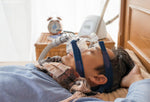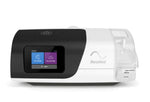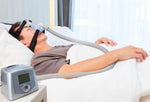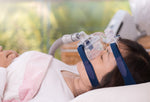On This Page
Types of CPAP Machines
Our editorial process includes extensive measures to verify accuracy, provide clarity on complex topics, and present factual information. Read more
Key Takeaways
- CPAP: delivers a continuous, fixed level of air pressure to keep your airway open during sleep
- BiPAP: uses two pressure settings: higher when you inhale, lower when you exhale
- APAP: automatically adjusts air pressure throughout the night based on your breathing patterns
- Travel CPAP: compact and lightweight, designed for portability without sacrificing effective therapy
Overview of PAP Therapy
Positive airway pressure (PAP) therapy is the most effective non-surgical treatment for obstructive sleep apnea and other sleep-related breathing disorders. PAP machines work by delivering a steady stream of pressurized air through a mask, keeping the airway open and preventing pauses in breathing during sleep.
Because PAP devices are FDA-regulated medical equipment, they require a prescription from a licensed health care professional. Your doctor will determine the right pressure settings and machine type based on the results of a sleep study.
When used consistently, PAP therapy can significantly improve sleep quality, reduce snoring, and lower the health risks associated with untreated sleep apnea.
Types of CPAP Machines
Not all CPAP machines work the same way. While every device delivers pressurized air to keep your airway open, the amount of pressure and how it’s delivered can vary. Understanding the differences between standard CPAP, APAP, BiPAP, and others can help you and your doctor choose the best option for you.
CPAP
CPAP machines are designed to deliver a constant level of pressure to the airways while you sleep. This flow of air prevents the tissues in your airways from collapsing during sleep, allowing for continuous breathing and also functioning as an anti-snoring device. Some CPAP machines include a pressure relief setting to slightly relieve pressure during exhalation.
Traditional CPAP machines are usually the most affordable and widely available type of PAP device. If you're newly diagnosed, your doctor will likely prescribe a CPAP machine and see how you respond.
Travel CPAP
Smaller and more compact, travel CPAP machines allow you to continue therapy even as you change locations. These machines still include a motor and CPAP tubing. Keep in mind that for these smaller, portable machines you should get spare batteries, as well as voltage adaptors, if you're traveling internationally.
Unfortunately, travel CPAP machines aren't typically covered by health insurance. Secondly, many portable CPAP machines don't come with some of the built-in features that the larger machines have and should not be used long-term.
BiPAP
Bilevel positive airway pressure (BiPAP) is one of the most popular types of PAP therapy devices. While CPAP machines work by providing a continuous steady flow of air throughout the night, the BiPAP machine works by providing two different air pressures, one for breathing in and another, lower pressure level for breathing out.
A BiPAP machine can sense when you inhale and exhale and tend to be more comfortable to use than CPAP machines. BiPAP therapy is often recommended for people with complex sleep related breathing disorders or issues. Because this is a more advanced type of PAP machine, it's also more expensive.
A doctor usually only prescribes BiPAP treatment for people with OSA if they don't respond to traditional CPAP therapy. Since BiPAP machines use two different pressure settings, an overnight titration study may be required to determine the right levels of pressure for your device.
APAP
Automatic positive airway pressure (APAP), also referred to as auto-CPAP, can raise or lower the pressure based on your breathing patterns. This is often more comfortable for restless sleepers, allergy sufferers, and those who had difficulty tolerating CPAP air flow.
The biggest difference between APAP and CPAP is their pressure settings. As you sleep, the APAP machine can increase pressure when it senses a respiratory event. However, they are also usually more expensive than traditional CPAP machines because of their advanced features.
EPAP
Expiratory positive airway pressure (EPAP) devices contain two valves that are inserted into the nostrils. Designed to allow a sleeper to breathe in as they normally would, the valves create resistance as the sleeper breathes out. This pressure makes the airway less likely to become narrowed or obstructed on the next inhaled breath.
EPAP therapy may help a user have fewer nighttime awakenings, reduced snoring, and fewer OSA-related lapses in breathing during sleep. However, additional studies need to be conducted for researchers to know how EPAP compares to CPAP and other available treatments for sleep apnea.
KPAP
Kairos positive airway pressure, or KairosPAP (KPAP), is an emerging form of PAP therapy designed to make sleep apnea treatment more comfortable and adaptive. Like traditional CPAP, it works by delivering pressurized air through a mask and tubing system to keep the airway open during sleep.
What makes KPAP different is its dynamic pressure delivery. Instead of maintaining one constant pressure throughout the night, the device adjusts airflow in real time based on where you are in your breathing cycle. This approach aims to provide effective sleep apnea treatment with greater comfort and potentially fewer side effects than standard CPAP therapy.
ASV
Adaptive servo‑ventilation (ASV) is an advanced PAP therapy often reserved for complex sleep-breathing disorders, especially central sleep apnea (CSA) or mixed/periodic breathing patterns. Unlike standard CPAP, ASV machines monitor your breathing patterns in real time and adjust pressure dynamically, even delivering a “backup breath” if breathing pauses.
How to Choose a CPAP Machine
Finding the best CPAP machine can make a big difference in how comfortable and effective your therapy feels. The best device for you will depend on your diagnosis, breathing needs, and personal preferences.
Talk to Your Doctor or Sleep Specialist
Your prescription will specify the type of PAP therapy you need—such as CPAP, APAP, or BiPAP—and your ideal pressure settings. A sleep specialist can also help you identify machines with features that improve comfort and compliance.
Prioritize Comfort and Usability
Look for features like a built-in humidifier, ramp settings, and quiet operation, which can make nightly use easier. Machines with heated tubing or auto-adjusting pressure may also help if you experience dryness or pressure discomfort.
Check Mask Compatibility
Not every mask fits every machine. Make sure your preferred mask type—nasal, full-face, or nasal pillow—is compatible with your CPAP device.
Think About Your Lifestyle
If you travel often, you may prefer a compact or travel CPAP that’s lightweight and FAA-approved. For home use, a full-size model with a humidifier and quiet motor may be ideal.
Consider Warranty, Support, and Your Budget
Choose a machine from a reputable manufacturer or provider that offers a solid warranty and reliable customer support in case you need assistance.
And while most CPAP machines are covered by insurance, you can also buy one out of pocket. Compare models based on value and comfort—not just cost—to find a device that fits your needs long term.
FAQs
What is a CPAP machine used for?
A CPAP machine is used to treat sleep apnea, in particular, obstructive sleep apnea. It allows for continuous breathing and prevents repeated periods of halted breathing during the night. There are several types of CPAP machines depending on your needs and budget.
Do you need a prescription for a CPAP machine?
Yes. CPAP machines are FDA-regulated medical devices and require a prescription from a licensed health care provider. Your prescription will include important details like the recommended pressure settings and mask type, which ensure that your therapy is both safe and effective.
Will insurance pay for a CPAP machine?
Most health insurance plans, including Medicare, cover CPAP machines when prescribed for sleep apnea. Coverage typically includes the machine, mask, tubing, and replacement supplies.
To qualify, you may need documentation from a sleep study confirming your diagnosis and proof that you’re using the device regularly. It’s best to check with your provider for specific coverage requirements.









